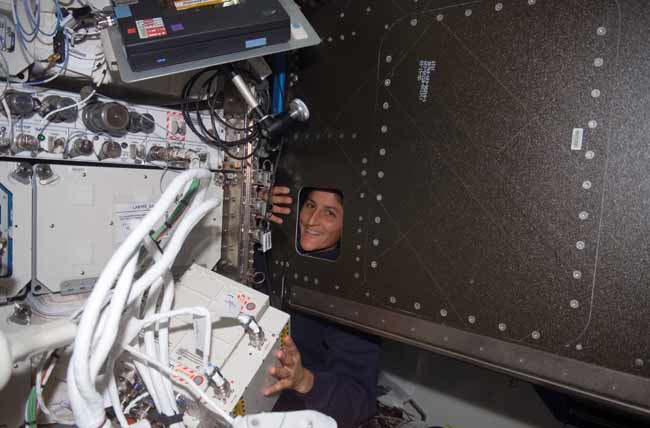Space Station Crew to Test New Oxygen Generator

HOUSTON --Astronauts aboard the International Space Station (ISS) will test a new U.S.oxygen generator that will prove vital for the outpost?s expansion to largercrews.
Working intandem with flight controllers on Earth, the station?s three-astronaut Expedition15 crew is expected to activate the outpost?s U.S.-built OxygenGeneration System for the first time since its delivery last year.
?We expectto generate, for the first time, U.S. oxygen from water,? said NASA?s deputyISS program manager Kirk Shireman during a Tuesday briefing.
Shuttleastronauts delivered theU.S. oxygen generator to the ISS in July 2006, but the new hardware had towait until another mission?s crew - last month?s STS-117 astronauts aboardAtlantis - installed and opened a newhydrogen vent valve outside the station?s Destiny laboratory. A softwareupgrade last week primed the oxygen generator for action, thought it won?t berequired for full use until the station ramps up to its full six-person crew in2009.
?This isjust a test,? Shireman said. ?If things go well, we expect to generate about 40hours of oxygen.?
Today?scheck is slated to begin in mid-afternoon, around 3:00 p.m. EDT (1900 GMT),NASA said.
The 1,500-pound(680-kilogram) U.S. oxygen generator uses electrolysis to separate water intobreathable oxygen and waste hydrogen, which is dumped overboard via a vent inNASA?s Destiny laboratory aboard the ISS. A similar Russian machine, dubbedElektron, performs the same function aboard the station?s Russian-built segmentand has served as the orbital laboratory?s primary oxygen generator to date.
Get the Space.com Newsletter
Breaking space news, the latest updates on rocket launches, skywatching events and more!
The currentElektron and oxygen stores aboard docked Russian cargo ships are sufficient tomeet the life support needs of current crews, but future ISS expeditionastronauts will find the U.S.-built oxygen generator vital for normaloperations, NASA said.
?It?s anadditional capability and an additional redundancy level,? Shireman said of theU.S. system right now. ?[But] it?s a major technology that?s required toproduce oxygen to support the six-person crew, and it?s a big step for us.?
- Air Apparent: New Oxygen Systems for the ISS
- SPACE.com Video Interplayer: Space Station Power Up with STS-117
- Complete ISS Expedition Coverage
Join our Space Forums to keep talking space on the latest missions, night sky and more! And if you have a news tip, correction or comment, let us know at: community@space.com.

Tariq is the Editor-in-Chief of Space.com and joined the team in 2001, first as an intern and staff writer, and later as an editor. He covers human spaceflight, exploration and space science, as well as skywatching and entertainment. He became Space.com's Managing Editor in 2009 and Editor-in-Chief in 2019. Before joining Space.com, Tariq was a staff reporter for The Los Angeles Times covering education and city beats in La Habra, Fullerton and Huntington Beach. In October 2022, Tariq received the Harry Kolcum Award for excellence in space reporting from the National Space Club Florida Committee. He is also an Eagle Scout (yes, he has the Space Exploration merit badge) and went to Space Camp four times as a kid and a fifth time as an adult. He has journalism degrees from the University of Southern California and New York University. You can find Tariq at Space.com and as the co-host to the This Week In Space podcast with space historian Rod Pyle on the TWiT network. To see his latest project, you can follow Tariq on Twitter @tariqjmalik.
